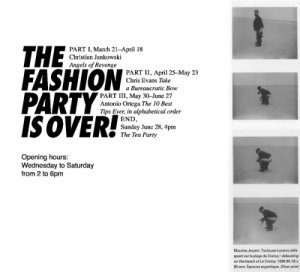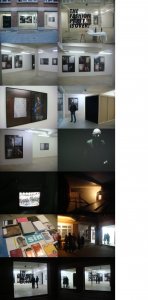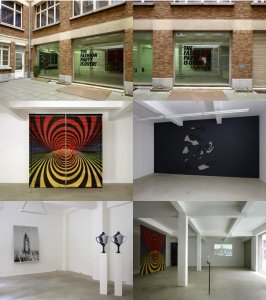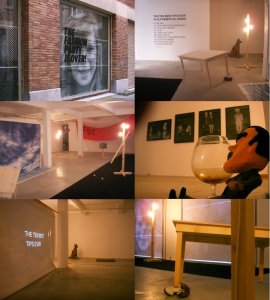Coming together in several distinct yet interconnected parts, this exhibition consists of three solo shows running in sequence: Christian Jankowski (DE), Chris Evans (UK) and Antonio Ortega (ES), along with a theatre production and an afternoon of screenings.
From Dadaism to Situationism to Punk, the last century saw the appearance of several undisciplined movements whose actions or productions constituted an immediate and visceral response to the status quo. Today, aside of reactionary stances, the possibilities of taking a confrontation position in the face of both apparent and implicit power structures often necessitates an oxymoronic collaborative subversiveness.
Exploiting both the art world as a sheltered field of experimentation and acknowledging its presence as an economic arena, the invited artists capitalize on these dynamics when producing work whose urgency lies in its direct engagement with the implicated agents of the status quo. Often humorous but never frivolous, Jankowski, Evans and Ortega’s practices are built on an exchange with others, often from outside the art world (televangelists, corporate power players, retired politicians, minor celebrities etc.) who contribute either to the conceptual or formal structure of their work. These collaborative approaches de-stabilize the rigidity of the position of the author, leaving the artist exposed to elements of chance and intrusion. Nevertheless, the strength of the work on view lies precisely in the fact that these insecure exchanges are absorbed into/re-interpreted into what becomes an artwork by even the most conventional of definitions, a classical sculpture, a series of photographs or perhaps even an oil painting.
Curated by Mai Abu ElDahab & David G. Torres
.
Part I: Christian Jankowski “Angels of Revenge”; March 21 – April 18
At a horror fair in Chicago, Jankowki confronts the participants of a costume competition with the following question: “How were you most wronged in your life, and what is your fantasy of revenge against the person responsible?” The ensuing photographs and video constitute Jankowski’s show at Objectif Exhibitions.
Christian Jankowski (1968, Goettingen, Germany) is a multi-media artist working in video, photography, performance and literature. Combining different mediums to blur the borders between fiction and reality, private and public, Jankowski’s work gently disarms his audience, subverting expectations and entertaining at the same time. Since gaining international recognition at the 48th Venice Biennale (1999), he has had numerous international solo exhibitions, the most recent of which include at Maccarone Inc., (New York, 2004 and 2007); Centre d’Art Santa Monica (Barcelona, 2007); Miami Art Museum (Miami, 2007); Klosterfelde (Berlin, 2008), Kunstmuseum (Stuttgart, 2008); and the Public Art Found (Central Park, New York, 2008-09).
.
Part II: Chris Evans "Take a bureaucratic bow"; April 25 - May 23
Born in Eastrington, UK, Chris Evans lives and works in Brussels. He often works in the spaces where patronage, be it private, corporate or political, meets art, muddling the roles of artist and patron, genius and muse. Despite his desire to make art that has at its outset political motivation, Evans is intent on maintaining its connection with personal, poetic or imaginative investigation.
The project of Chris Evans “AS SIMPLE AS YOUR LIFE USED TO BE” was constructed in two stages, although both turn around a same context: a school in the outskirts of Rome.
First stage. Chris Evans interviewed to four elderly Italian politicians: Emanuele Macaluso (former member of the Italian Communist Party), Oscar Mammi (former member of the Italian Republican Party), Giulio Caradonna (former member of the Italian Social Movement - National Right Party) and Giulio Andreotti (former member of the Christian Democratic Party). In all the cases they were asked on the sacrifice. The proposal of Evans consisted of, from the interviews, to make a series of sculptures for that school in the outskirts of Rome. The contributions of the politicians, done from the experience, from the long years in the political decision making, the use of the political power and from the position of the “Emperors”, had to serve as something for the young people, teenagers, in the heat of stage of construction of their lives, from the margins of one capital like Rome. In any case, the experience would contrast with a so distant life and so to do as the ones of students in the school. What learning could remove from the idea of sacrifice from old politicians? To what point the distances between ones and others would be clear? The result: a horizon op, a faucet with a poetic key, a strange wall to practice scaling and a uniform with blue cloud formed by a hand that holds a dull match… Strange ideas to ilustrate sacrifice.
Second stage. More literal, less poetic and abstract a sacrifice than much more manifest the distance between the young people and those old politicians. In a video a young girl shows of her confusion from the one she is in love. He, nevertheless, is distracted. His mind seems to be in the control of an unspecified political agency. In order to save him and to save its love, she talks with a friend. Her doubt is if to denounce him to the authorities and, nevertheless, to sacrifice its love. But then what other choice are you left with when your lover’s whispered sweet-nothings sound suspiciously like John Robinson’s 18th century text, ‘Proofs of a Conspiracy Against All Religions and Governments in Europe’?
The politicians would have to be pragmatic, the teenagers poetical; ones confronted to the reality and a experience, the others to the illusions and the future. Nevertheless, pragmatic and poetic are is the other way around. While sacrifice it is perceived by like something abstract, by others it’s real and affects its lives. experience ended in poetical resolutions; ilusions ended in simple problems.
If the proposals of Evans are not as much artifacts as investigations and experiments in which to put the social thing on approval, the politician, intimate and the paper that can play the art like mediator, we would agree to ask: what kind of representatibility holds the formal policy? if the distance between a vision of the confronted sacrifice in abstract to a vital sacrifice shows to the distance between the political speech and the remote reality of teenagers in love story in a city outskirts? or what means commitment in the cultural practices? Perhaps to unravel those distances, to play between opposed poles to show absurd or the intrascendente dressed importance.
.
Part III: Antonio Ortega "The best 10 tips ever, in alphabetical order"; May 30 - June 27
In his role as an artist, Antonio Ortega sees himself as a service-provider and a tertiary sector worker. From this particular viewpoint, Ortega has been engaged in a long-term project (The World According to Antonio Ortega) that encapsulates this practice of supplying ideas, concepts and commentary on contemporary life as he sees it. He is at once an amateur and unscientific sociologist looking at human behavior, and an ethologist looking at animals in the urban environment, and often the intersection of the two.
For his show at Objectif Exhibitions, Ortega publishes his ‘formula for success’, the culmination of his research based on everyday observations and personal experience. This formula (in the form of 10 tips) is not ironic or cynical, but is intended to be useful. As simple as these tips might appear (eg. 06. Don’t Smile), they are not easy to achieve as exemplified by Ortega ‘s own failed experience.
Ortega’s work comprises neither metaphor or proposition, nor representation but rather is immediate and experiential. However, for his exhibition, Ortega experiments in this unique collaboration with Teatre Kaddish to translate his work into a theatrical representation. However, the partnership comes naturally as the language of Teatre Kaddish (whose recent pieces are based on research into contemporary art) is as visceral and unloaded as the directness of Ortega’s practice.
The work of Antonio Ortega (1968, Sant Celoni, Spain) deals with social behavior. He often creates “records”, employing a strategy similar to that of a fable, with easily recognizable references exemplifying or illustrating different situations. From a naïve position devoid of any cynicism, Ortega observes with a permanent sense of perplexity and doubt, the mechanisms that define the dynamics of artistic production and its purpose in society. Ortega’s most recent solo shows include Galerie Elisabeth & Klaus Thoman, (Innsbruck, 2008), Fundació Joan Miró (Barcelona, 2004), Abteiberg Museum (Moenchengladbach, 2003), The Showroom (London, 2002) and he has been included in several group exhibitions including Galerie Micheline Szwajcer (Antwerp, 2008), Malmö Konsthall (Malmö, 2008), and Bloomberg Space (London, 2006).
Teatre Kaddish is a contemporary experimental theater group based in Barcelona. The company was founded in 1975 by Josep Costa and has since given over 170 performances. Today, led by Xavier Giménez Casas, Teatre Kaddish is one of the most active independent theater companies in Spain. The company’s previous performances include pieces such as “Cabaret Voltaire” or other plays based on texts by Ionesco, Antonin Artaud, Carles Hac Mor-Esther Xargay, Allen Ginsberg and Samuel Beckett.
Theatre credits:
Author: Antonio Ortega
Direction: Xavier Giménez Casas
Producer: David G. Torres
Dramatization: Teatre Kaddish
Scenery: Rafel G. Bianchi and Dolors Juárez
Music: Daniel Granados / Producciones Doradas and Make
Graphic design: Alex Gifreu / Bis
Acting: Xavier Llorens, Arnau Puig i Albert Riballo
Documentation: Marta Tomás
Commissioned by: Objectif Exhibitions
.
Part IV: "The tea party", afternoon of screenings; June 28
Curated by Mai Abu ElDahab & David G. Torres
Objectif Exhibitions; Kleine Markt 7-9; Antwerp 2000; Belgium






